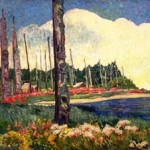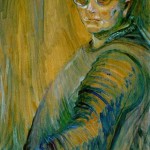Emily Carr’s Forest
Categories: Reviews
A snowy afternoon and moments ago I wrote the last sentence in the first draft of book three. I will need to start revising soon, and I want to do so with Emily Carr’s words before me.
A friend recently loaned me her complete works. It seems she is famous, especially in Canada, for not only her writing, but also her painting. She lived in the early 1900s and the thing is, she lived and wrote about places close by. Victoria BC, the forests, the Haida people. How did I miss out on her works? I’m surprised I didn’t learn about her in school.
She talks about ‘peeling’ a sentence back to its bare essence. That image sticks with me as I begin revising. Looking deep into story structure, at each individual word.
Emily Carr went into remote, abandoned Haida villages and sketched and painted the totem poles she found still standing. She also then wrote about those experiences. Those poles were old back then, and it’s doubtful any still stand now. But she captured them and gave us their history, so that they will never be forgotten. When I read her words I wish I could see them as they were then.
The book I’m reading is called ‘The Complete Writings of Emily Carr’ and of course comes with introductions and forewords before each piece. These are worth reading as they were written by those who knew her intimately and give the reader honest views of Emily. When you read those, and think about the period she lived in, you realize she was an extremely unique woman for her time. What courage it must have taken, and really, what self-confidence, to stand against the norm, the traditions, and to live life the way she wanted.
Her writing is well worth delving into, especially this book with the background that’s offered.
When I look at her paintings I can feel the forest alive and breathing. I can sense movement of wind, feel the cool mist. I don’t know how she does that, bringing the woods alive through word and paint.
Here is a sample, taken from her complete works, in which she talks about the totem, the Wild Woman of the Woods, D’Sonoqua. Alone in a village, she went exploring, beat through a nettle field and fell at this totem’s feet. After reading this I longed for that same moment of stumbling onto old magic in the forest.
“Her head and trunk were carved out of, or rather into, the bole of a great red cedar. She seemed to be part of the tree itself, as if she had grown there at its heart, and the carver had only chipped away the outer wood so that you could see her. Her arms were spliced and socketed to the trunk, and were flung wide in a circling, compelling movement. Her breasts were two eagle-heads, fiercely carved. That much, and the column of her great neck, and her strong chin, I had seen when I slithered to the ground beneath her. Now I saw her face.
‘The eyes were two rounds of black, set in wider rounds of white, and placed in deep sockets under wide, black eyebrows. Their fixed stare bored into me as if the very life of the old cedar looked out, and it seemed that the voice of the tree itself might have burst from that great round cavity, with projecting lips, that was her mouth…’
Wow!
And I’m only a quarter of the way into the book. Find it if you can, and read the words of this extraordinary woman. I also strongly encourage you to do an internet search on images of Emily Carr’s artwork. Look especially at the pieces where the colors are dark greens, the style almost simplistic until you look closely.
Then let me know if her words reach across the years to you, too.
